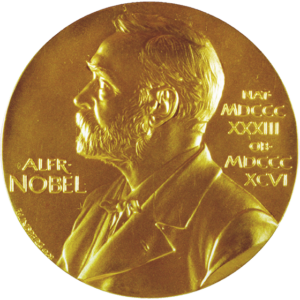The Royal Swedish Academy of Sciences has decided to award the Nobel Prize in Chemistry 2018 with one half to Frances H. Arnold, California Institute of Technology, Pasadena, USA and the other half jointly to George P. Smith, University of Missouri, Columbia, USA and Sir Gregory P. Winter, MRC Laboratory of Molecular Biology, Cambridge, UK.
The Royal Swedish Academy of Sciences has decided to award the Nobel Prize in Chemistry 2018
with one half to Frances H. Arnold, California Institute of Technology, Pasadena, USA
“for the directed evolution of enzymes”
and the other half jointly to George P. Smith, University of Missouri, Columbia, USA and Sir Gregory P. Winter, MRC Laboratory of Molecular Biology, Cambridge, UK
“for the phage display of peptides and antibodies”.
They harnessed the power of evolution
 The power of evolution is revealed through the diversity of life. The 2018 Nobel Laureates in Chemistry have taken control of evolution and used it for purposes that bring the greatest benefit to humankind. Enzymes produced through directed evolution are used to manufacture everything from biofuels to pharmaceuticals. Antibodies evolved using a method called phage display can combat autoimmune diseases and in some cases cure metastatic cancer.
The power of evolution is revealed through the diversity of life. The 2018 Nobel Laureates in Chemistry have taken control of evolution and used it for purposes that bring the greatest benefit to humankind. Enzymes produced through directed evolution are used to manufacture everything from biofuels to pharmaceuticals. Antibodies evolved using a method called phage display can combat autoimmune diseases and in some cases cure metastatic cancer.
Since the first seeds of life arose around 3.7 billion years ago, almost every crevice on Earth has filled with different organisms. Life has spread to hot springs, deep oceans and dry deserts, all because evolution has solved a number of chemical problems. Life’s chemical tools – proteins – have been optimised, changed and renewed, creating incredible diversity.
This year’s Nobel Laureates in Chemistry have been inspired by the power of evolution and used the same principles – genetic change and selection – to develop proteins that solve mankind’s chemical problems.
One half of this year’s Nobel Prize in Chemistry is awarded to Frances H. Arnold. In 1993, she conducted the first directed evolution of enzymes, which are proteins that catalyse chemical reactions. Since then, she has refined the methods that are now routinely used to develop new catalysts. The uses of Frances Arnold’s enzymes include more environmentally friendly manufacturing of chemical substances, such as pharmaceuticals, and the production of renewable fuels for a greener transport sector.
The other half of this year’s Nobel Prize in Chemistry is shared by George P. Smith and Sir Gregory P. Winter. In 1985, George Smith developed an elegant method known as phage display, where a bacteriophage – a virus that infects bacteria – can be used to evolve new proteins. Gregory Winter used phage display for the directed evolution of antibodies, with the aim of producing new pharmaceuticals. The first one based on this method, adalimumab, was approved in 2002 and is used for rheumatoid arthritis, psoriasis and inflammatory bowel diseases. Since then, phage display has produced anti-bodies that can neutralise toxins, counteract autoimmune diseases and cure metastatic cancer.
We are in the early days of directed evolution’s revolution which, in many different ways, is bringing and will bring the greatest benefit to humankind.

Frances H. Arnold, born 1956 in Pittsburgh, USA. Ph.D. 1985, University of California, Berkeley, USA. Linus Pauling Professor of Chemical Engineering, Bioengineering and Biochemistry, California Institute of Technology, Pasadena, USA.
George P. Smith, born 1941 in Norwalk, USA. Ph.D. 1970, Harvard University, Cambridge, USA. Curators’ Distinguished Professor Emeritus of Biological Sciences, University of Missouri, Columbia, USA.
Sir Gregory P. Winter, born 1951 in Leicester, UK. Ph.D. 1976. University of Cambridge, UK. Research Leader Emeritus, MRC Laboratory of Molecular Biology, Cambridge, UK.
Prize amount: 9 million Swedish krona, with one half to Frances Arnold and the other half to be shared between George Smith and Gregory Winter.
The Royal Swedish Academy of Sciences, founded in 1739, is an independent organisation whose overall objective is to promote the sciences and strengthen their influence in society. The Academy takes special responsibility for the natural sciences and mathematics, but endeavours to promote the exchange of ideas between various disciplines.
Nobel Prize® and the Nobel Prize® medal design mark are registered trademarks of the Nobel Foundation.
Documents
The illustrations are free to use for non-commercial purposes. Attribute ”©Johan Jarnestad/The Royal Swedish Academy of Sciences”.
Illustration: Enzyme evolution
Illustration: Antibody evolution
Contact
Expert
Sara Snogerup Linse, member of the Nobel Committee for Chemistry, The Royal Swedish Academy of Sciences
+46 70 250 77 66, sara.linse@biochemistry.lu.se
Press contact
Kajsa Waaghals, Press Secretary, The Royal Swedish Academy of Sciences
+46 70 878 67 63, kajsa.waaghals@kva.se
More information
The Laureates
Frances H. Arnold, California Institute of Technology
George P. Smith, University of Missouri
Sir Gregory P. Winter, MRC Laboratory of Molecular Biology
Articles
Arnold, F. and Macuare, K. A. (2016) The NAI Fellow Profile: An Interview with Dr. Frances Arnold. Technology and Innovation, 18, 79-82
Harding, A. (2006) Profile Sir Greg Winter – humaniser of antibodies. Lancet, 368, S50
Nightingale, K. (2013) Greg Winter: Pioneering antibody drugs. Insight
Trager, R. (2018) In situ with Frances Arnold. Chemistry World
Video
Molecular Frontiers Symposium and Youth Forum (23 maj 2017) Frances Arnold: New enzymes by evolution
SlidesLive (23 Nov 2015) Therapeutics Antibodies: A Revolution in Pharmaceuticals